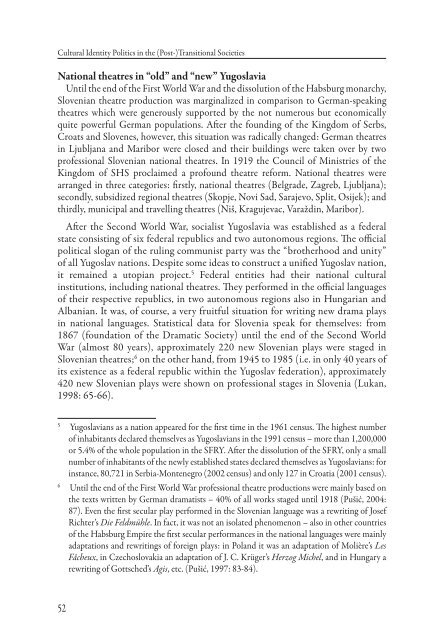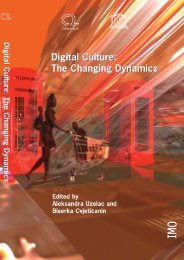free download in pdf format - Culturelink Network
free download in pdf format - Culturelink Network
free download in pdf format - Culturelink Network
You also want an ePaper? Increase the reach of your titles
YUMPU automatically turns print PDFs into web optimized ePapers that Google loves.
Cultural Identity Politics <strong>in</strong> the (Post-)Transitional Societies<br />
National theatres <strong>in</strong> “old” and “new” Yugoslavia<br />
Until the end of the First World War and the dissolution of the Habsburg monarchy,<br />
Slovenian theatre production was marg<strong>in</strong>alized <strong>in</strong> comparison to German-speak<strong>in</strong>g<br />
theatres which were generously supported by the not numerous but economically<br />
quite powerful German populations. Aft er the found<strong>in</strong>g of the K<strong>in</strong>gdom of Serbs,<br />
Croats and Slovenes, however, this situation was radically changed: German theatres<br />
<strong>in</strong> Ljubljana and Maribor were closed and their build<strong>in</strong>gs were taken over by two<br />
professional Slovenian national theatres. In 1919 the Council of M<strong>in</strong>istries of the<br />
K<strong>in</strong>gdom of SHS proclaimed a profound theatre reform. National theatres were<br />
arranged <strong>in</strong> three categories: fi rstly, national theatres (Belgrade, Zagreb, Ljubljana);<br />
secondly, subsidized regional theatres (Skopje, Novi Sad, Sarajevo, Split, Osijek); and<br />
thirdly, municipal and travell<strong>in</strong>g theatres (Niš, Kragujevac, Varažd<strong>in</strong>, Maribor).<br />
Aft er the Second World War, socialist Yugoslavia was established as a federal<br />
state consist<strong>in</strong>g of six federal republics and two autonomous regions. Th e offi cial<br />
political slogan of the rul<strong>in</strong>g communist party was the “brotherhood and unity”<br />
of all Yugoslav nations. Despite some ideas to construct a unifi ed Yugoslav nation,<br />
it rema<strong>in</strong>ed a utopian project. 5 Federal entities had their national cultural<br />
<strong>in</strong>stitutions, <strong>in</strong>clud<strong>in</strong>g national theatres. Th ey performed <strong>in</strong> the offi cial languages<br />
of their respective republics, <strong>in</strong> two autonomous regions also <strong>in</strong> Hungarian and<br />
Albanian. It was, of course, a very fruitful situation for writ<strong>in</strong>g new drama plays<br />
<strong>in</strong> national languages. Statistical data for Slovenia speak for themselves: from<br />
1867 (foundation of the Dramatic Society) until the end of the Second World<br />
War (almost 80 years), approximately 220 new Slovenian plays were staged <strong>in</strong><br />
Slovenian theatres; 6 on the other hand, from 1945 to 1985 (i.e. <strong>in</strong> only 40 years of<br />
its existence as a federal republic with<strong>in</strong> the Yugoslav federation), approximately<br />
420 new Slovenian plays were shown on professional stages <strong>in</strong> Slovenia (Lukan,<br />
1998: 65-66).<br />
5 Yugoslavians as a nation appeared for the fi rst time <strong>in</strong> the 1961 census. Th e highest number<br />
of <strong>in</strong>habitants declared themselves as Yugoslavians <strong>in</strong> the 1991 census – more than 1,200,000<br />
or 5.4% of the whole population <strong>in</strong> the SFRY. Aft er the dissolution of the SFRY, only a small<br />
number of <strong>in</strong>habitants of the newly established states declared themselves as Yugoslavians: for<br />
<strong>in</strong>stance, 80,721 <strong>in</strong> Serbia-Montenegro (2002 census) and only 127 <strong>in</strong> Croatia (2001 census).<br />
6 Until the end of the First World War professional theatre productions were ma<strong>in</strong>ly based on<br />
the texts written by German dramatists – 40% of all works staged until 1918 (Pušić, 2004:<br />
87). Even the fi rst secular play performed <strong>in</strong> the Slovenian language was a rewrit<strong>in</strong>g of Josef<br />
Richter’s Die Feldmühle. In fact, it was not an isolated phenomenon – also <strong>in</strong> other countries<br />
of the Habsburg Empire the fi rst secular performances <strong>in</strong> the national languages were ma<strong>in</strong>ly<br />
adaptations and rewrit<strong>in</strong>gs of foreign plays: <strong>in</strong> Poland it was an adaptation of Molière’s Les<br />
Fâcheux, <strong>in</strong> Czechoslovakia an adaptation of J. C. Krüger’s Herzog Michel, and <strong>in</strong> Hungary a<br />
rewrit<strong>in</strong>g of Gottsched’s Agis, etc. (Pušić, 1997: 83-84).<br />
52



